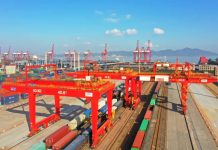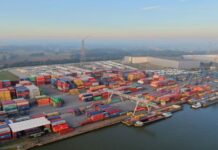
As the dockers on the US East Coast start their industrial action, there are conflicting reports on the effects on supply chains caused by the work stoppage, ranging from higher rates to widespread backlogs and congestion.
Hong Kong consultancy Linerlytica has warned that the shipping lines have not done enough to mitigate the potential for chaos and claims that the strike has thrown the container shipping market into “turmoil” with the lack of government intervention seen as adding to the disruption.
Carriers have been slow to respond to the threat of industrial action, only recently applying disruption charges, announcing port omissions, or discharging cargo at upstream facilities.
“On the eve of the port strike on 29 September 2024, there were 54 container ships of 371,000 TEUs docked at ports on the East Coast with a further 90 ships of 505,000 TEUs that are scheduled to call at the East Coast in the next seven days with the build-up of ships expected to cause severe port congestion over the coming weeks,” said a Linerlytica report.
Linerlytica, as with all the analysts, point out that any disruption will become more intense the longer the work stoppage continues, backing cargo up at export ports and prolonging the recovery period.
It is for this reason that Xeneta’s chief analyst Peter Sand believes government will intervene if the strike carries on into next week, “they [government] can’t let the strike can’t go on forever,” he said.
Drewry’s ports analyst Eleanor Hadland expected port preparations for the strike will limit supply chain disruptions: “Hopefully most cargo has been moved out of the ports before the strike.”
According to Hadland, any cargo diversions will have happened some weeks or months ago, as witnessed by the rapid growth seen in US West Coast ports as shippers divert their freight away from the EC and Gulf port region.
“Shippers have been strategically analysing supply chains to limit the effects of the disruption,” said Hadland, who added that in addition to the USWC alternative, there are options in Canada and Mexico for Asian freight.
Moreover, shippers are looking to store some freight in Caribbean hubs, ready for delivery after the strike, while fresh cargo, which cannot be stored, will simply be diverted to other markets. Problems could arise for shippers in export areas like Brazil where there are few alternative options for freight.
“If it’s a short sharp strike, around a week, then a weekend’s overtime could deal with any backlog of cargo, but if the strike is prolonged then the backlogs will start to build up in export regions, such as Europe, where cargo will simply not be shipped as it has no discharge point,” explained Hadland.
Meanwhile, digital optimisation advisor Vinturas’ GM, Alexander Style argues that savvy retailers will have been preparing for any delays by stockpiling cargo to buffer against supply chain delays.
“As we saw last month with the rail strikes in Canada, government intervention to prevent economic shut down doesn’t guarantee anything outside the short term,” said Style, “What this demonstrates is just how at-risk businesses that rely on single vendors and single modes of transport are. In today’s world, businesses can’t afford an ‘all eggs in one basket’ approach to their supply chains.”
It is the threat of such delays that led Drewry to reportedly say it expects USEC cargo rates to rise as a consequence of the strike, Philip Damas, MD at Drewry Supply Chain Advisors, reportedly said that any disruption will allow carriers to raise rates.
“We believe the US East Coast/Gulf Coast port strike will contribute to higher prices for the remainder of this year, and potentially next year too, depending on the duration,” said Damas.
Dynamar’s consultant Darron Wadey believes that even if the rates themselves do not increase surcharges have already been announced and that will have the same effect as actually raising rates.
“For example MSC has announced additional charges for a range of trade lanes with the US East/Gulf coast, most of which are either US$1,000/TEU, new or on top of already advised surcharges, to take effect late in October, while Hapag-Lloyd has already announced a surcharge of US$1,000/TEU for imports from Asia to also take effect in the second half of the month.”
Mary Anne Evans
Correspondent at Large





